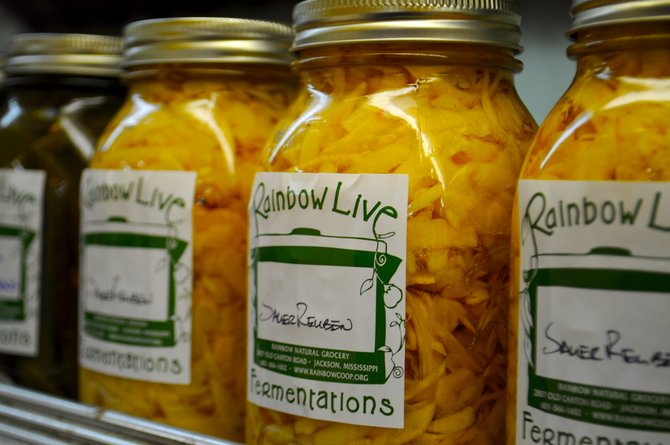Locally, Rainbow is a great source for sauerkrauts (and other sauer-foods) rich in probiotics. Photo by Trip Burns.
Modern homesteaders, that is, urban and rural folks who are into self-sufficiency, could do little better in regard to their food choices than delving into probiotics.
Simply put, probiotics are the tiny organisms that help maintain the natural balance (microflora) in the intestines. That may sound yucky, but it can be tastier than it might sound.
If you visit Rainbow Natural Grocery Co-Op in Fondren, for example, you'll see row after row of "natural" sauerkrauts in a remarkable variety of flavors. That's probiotics.
If you dine at a fine Asian restaurant and sample the spicy and wonderfully complex flavors of kimchi, that's probiotics.
Finally, if you grew annoyed at the Jamie Lee Curtis TV ads touting how her body is in such great intestinal balance, that's (yes, you guessed it) probiotics.
Probiotics is a form of homesteading because it's all about taking leftover or common materials and recycling them into healthful, edible food.
The "sauerkrauts" at Rainbow are carefully fermented unsold produce; Kimchi, basically, is fermented cabbage that was too tough or bitter to eat straight from the fields; Curtis' product is yogurt with a trademarked probiotic culture added.
It all boils to lacto-fermentation: a long word for homegrown food. As my beautiful wife Annette has blogged (blueskywaters.com/articles.html): Dr. Andrew Weil makes his own sauerkraut, not because it's a way to preserve summer crops and eat them all year, or a cheap way to recycle old, tough, bug-eaten or leftover garden crops (which it is) but because it's a healthier way to eat.
"Fermenting does some of the digestive work for you, so it makes a lot of foods more digestible and the nutrients in them more bioavailable," Weil says. Unlike other methods of preserving foods, lacto-fermentation actually increases nutritional value.
There are a couple of methods for doing this. Weil uses a Harsch crock, as does Rainbow Grocery, but that takes weeks to produce, and they are rather pricey. Annette uses a cheaper method that's also quicker. Read about it at store.therawdiet.com/ pisaandkimch.html.
She writes: "I use the sea salt proportion Weil recommends (jfp.ms/DrWeil), then add any veggie combination that appeals to me. I always add fresh grated ginger and fresh grated turmeric if available. I go easy on garlic, as the process makes its flavor stronger. You don't have to use a starter, but I do. Yogurt whey, miso, kraut juice or a capsule or two of a probiotic culture is fine."
Read about more fermentation methods and recipes in the book "Wild Fermentation: The Flavor, Nutrition, and Craft of Live-Culture Foods" by Sandor Ellix Katz (Chelsea Green, 2003, $25).
Jim PathFinder Ewing is a journalist, author, writer, editor, organic farmer and blogger. His latest book, "Conscious Food: Sustainable Growing, Spiritual Eating" (Findhorn Press), is in bookstores now. Find Jim on Facebook or follow him @edibleprayers or @organicwriter or visit blueskywaters.com.
Vegans Take Note!
"Sauerkraut is a perfect alternative source of acidophilous and other friendly micro-flora, for those who prefer not to eat yogurt. These flora aid digestion, boost the immune system, and help to keep your digestive system balanced and detoxified." --Dr. Andrew Weil
Make Your Own Yogurt
Everything you need to make homemade yogurt is probably already in your kitchen, with the possible exception of a thermometer. Visit makeyourownyogurt.com/make-yogurt/what-you-need.



Comments
Use the comment form below to begin a discussion about this content.
comments powered by Disqus